Resilience is top of mind for executives today, and it will prove to be a key factor for winning in the 2020s. As the world of business grows increasingly uncertain and volatile, companies that have purposefully developed capabilities to tackle ambiguity and unpredictability—in a word, resilience—are most likely to thrive.
Companies’ resilience is being tested as never before. Consumer spending in the US fell by almost 20% during the first two months of COVID-19’s explosive spread across the country, according to the US Department of Commerce, even as the pandemic disrupted 75% of supply chains, according to the Institute for Supply Chain Management.
Customer priorities and touch points are changing rapidly, and the massive shift to remote working poses a major risk to companies’ IT infrastructure . Consequently, as a recent BCG study shows, approximately 60% of companies expect to report at least a 10% decrease in revenue and earnings in 2020.
In this bleak context—and in general—resilience is a key driver of value. Some companies outperform their peers during downturns while many others lose ground or don’t survive. In the past four downturns since 1985, about one in seven companies increased both its sales growth rate and its profit margins, according to a 2019 BCG study . Despite the challenging circumstances, these successful companies grew their sales by 14 percentage points more and improved their margins by 7 percentage points more than the 44% of companies that declined on both parameters.
Even before the COVID-19 crisis erupted, many companies were struggling to keep pace with technological change. The challenge has only accelerated since the pandemic began, bringing a growing realization into sharp focus: the future of work and life will be more digital than people previously imagined. With almost every organization having to depend on data, analytics, digital tools, and automation, digital technologies will constitute an increasingly critical element of business resilience tomorrow.
The Phases of Resilience
Much has been said about resilience in recent times, but people often overlook its duality. It isn’t just about springing back from a crisis, as commonly understood; it is also about springing forward into a new reality.
A resilient company, our studies show, responds immediately to safeguard itself from an exigency, recovers from adversity so that it is in a position to outperform its peers, and then reimagines its business to get—and stay—ahead of rivals in an ever-changing future. Tackling the current COVID-19 crisis, for instance, requires companies to plan for three phases, each with its own objectives. (See Exhibit 1.) Depending on its geography and industry, a company could operate in more than one phase simultaneously.
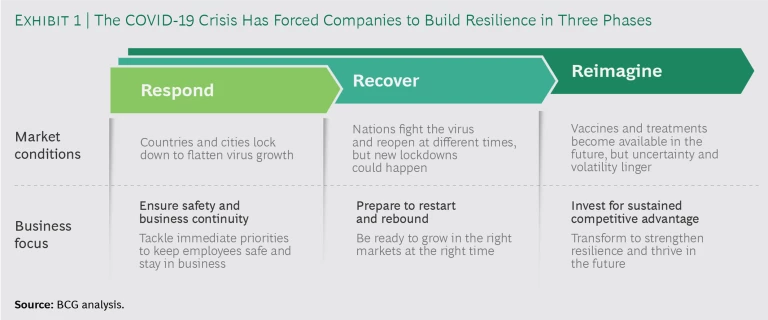
By now, most companies have addressed the immediate priorities of the Respond phase of resilience by, for instance, keeping employees safe, changing their ways of working, and dealing with key operational issues such as supply chain disruptions. Their focus now is on restarting and rebounding by adjusting quickly to the new realities on the ground. During that Recover phase, business will have to cope with uncertainty in demand, supply, labor markets, and credit availability. Traditional forecasts and operational processes are unlikely to be effective, so companies must develop data-driven sense-and-respond approaches to tackle the volatility and must learn to adjust rapidly to fast-changing scenarios.
The process of building resilience also has a critical Reimagine phase, which involves preparing the business for the future. The current situation is likely to result in permanent shifts in consumer and employee behavior, and some industries and business models will be irreversibly disrupted. As the nature of competition shifts, however, resilient companies will have a clear opportunity to emerge stronger. For this reason, companies should start laying the foundations of sustainable advantage by building resilience now.
Why Digitally Enabled Resilience Matters
A company needs to embed resilience in every aspect of the organization, from its go-to-market approach to its operations to its most critical infrastructure. Vulnerabilities in any area could affect the business’s ability to survive and thrive.
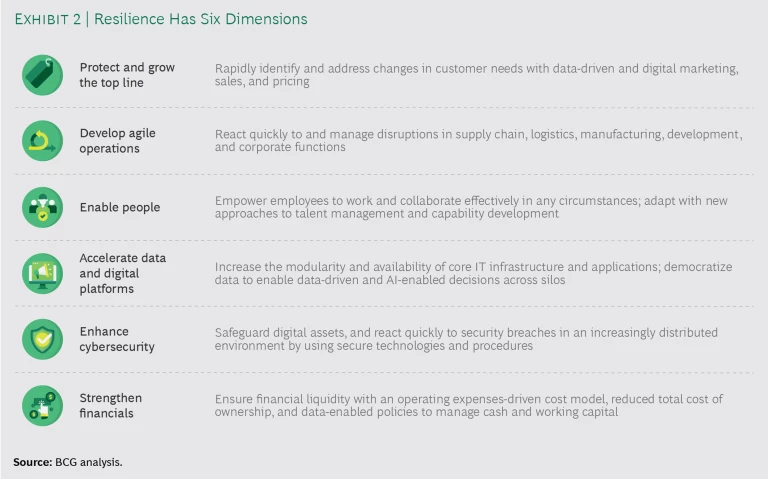
Through our work with companies across industries and around the world, we have identified six dimensions of resilience on which business leaders must focus: protecting and growing the top line; developing agile operations; enabling people; accelerating the adoption of data and digital platforms; enhancing cybersecurity; and strengthening financials. (See Exhibit 2.) Resilience comes from each of these dimensions, but business leaders must also consider them in combination, in order to gain resilience from their interactions.
Technological capabilities are instrumental in building resilience in all six dimensions. Resilient companies are likely to adopt an operating model with an integrated view of the relationship between people and technology—what we call the The Bionic Company —which brings out the best in both. Doing so results in superior financial outcomes, almost doubling earnings growth and contributing to a 2.4x increase in the growth rate of enterprise value .
Digital transformation has therefore become more crucial than ever. In a recent BCG survey, 75% of executives agreed that they regard digital transformation as becoming more urgent in light of the COVID-19 crisis, and 65% said that they anticipate increasing their investments in digital transformation. As almost every organization’s dependence on digital technologies grows, it is hardly an exaggeration to say that adopting and managing digital technologies will be critical to business resilience.
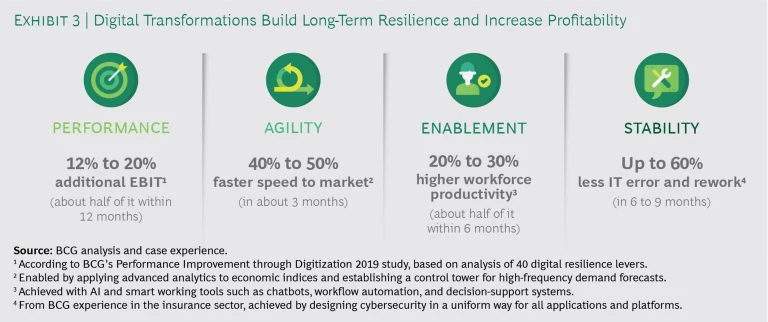
Done right, a digital transformation will not only build long-term resilience, increasing speed to market, workforce productivity, and stability. It will also deliver short-term financial gains . (See Exhibit 3.) Companies that use digital levers can expect their profit margins to increase, on average, by 12% to 20%. They will generate as much as 50% of the additional profits in the first year, thereby generating the resources needed to fund the rest of the transformation journey. This characteristic is particularly relevant today. More than 80% of transformations will be self-funded, according to BCG research, and most companies expect that they will have to institute tighter funding policies in the current circumstances.
A word of caution, though. A BCG study suggests that fewer than 30% of companies successfully capture value from digital transformations . Their success depends on defining a clear vision linked to strategy and value, ensuring leadership commitment and governance of results, and building critical technological and human capabilities .
Tech + Us: Monthly insights for harnessing the full potential of AI and tech.
Three Steps to Develop Digital Resilience
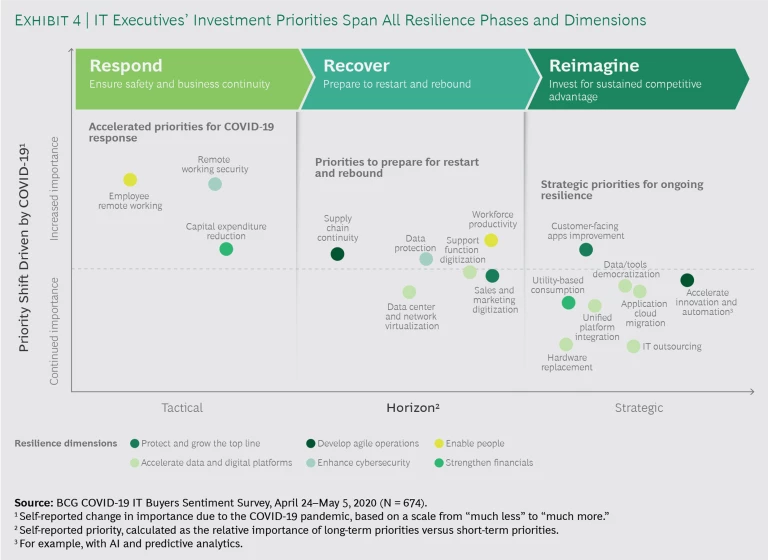
It’s important for companies to build digital resilience when and where they will need it most. Many of them have already increased their investments in secure remote working technology and reduced their capital expenditure to respond to their immediate needs, according to a recent BCG analysis of the investment priorities of around 700 IT executives in the US. (See Exhibit 4.) Companies also continue to invest in the digital levers that will allow them to grow during the recovery by, for instance, ensuring supply chain continuity and digitizing critical parts of the business. Most are also continuing to invest in strategic priorities to build ongoing resilience, by expanding and strengthening data and digital platforms, and doubling down on automation.
Given today’s acute resource constraints and the pressing need to accelerate change programs, prioritization is critical. Companies can follow a three-step approach to tailor priorities to their specific situation and needs. Their decisions will depend both on endogenous factors, such as their organization’s current resilience maturity—including financial strength—and on exogenous factors, such as the impact of COVID-19 and the potential for digital disruption.
Step 1: Address Imperatives to Respond and Recover
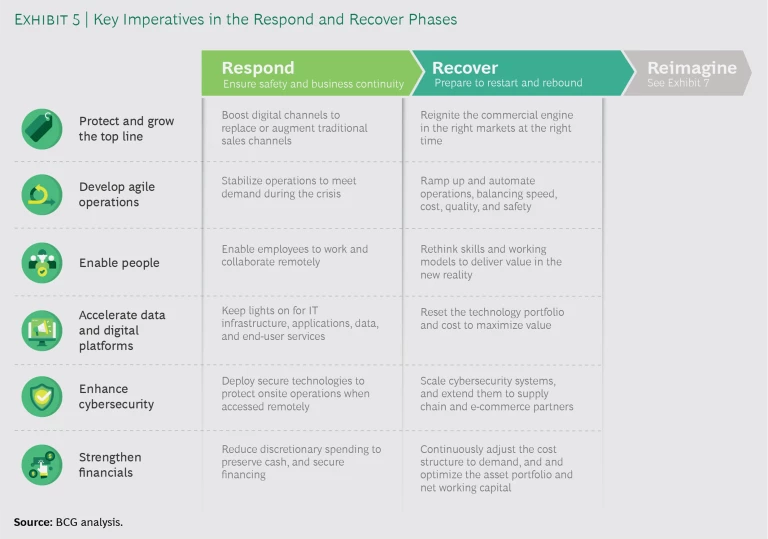
The starting point in this three-step process is to address the issues resulting from lockdowns and to support business performance as markets recover. Companies must tailor their actions to their particular contexts, but most companies have taken a number of common actions in the Respond and the Recover phases. (See Exhibit 5.)
Many companies, we find, struggle in their efforts to respond and recover rapidly. In their initial response, companies must focus on business outcomes that will deliver the most value in the shortest time, such as protecting and growing the top line and developing agile operations. That’s why efforts to switch to digital marketing and e-commerce and to develop a data-driven supply chain are often high on the agenda today.
To accelerate during the recovery, a company must focus on tangible, short-term opportunities, and employees must develop new skills and adapt to new ways of working. Most changes will relate to the development and deployment of digital capabilities, so business leaders need to move closer to technology teams.
Step 2: Reimagine the Future and Set Ambitions
Once companies have dealt with their immediate priorities, they must turn to their ambitions for the future—in particular, preparing to win in the new reality. They need to determine the scope of their ambitions and the pace at which they must develop resilience.
In setting the scope of their ambition, companies should identify specific, critical resilience dimensions on which to differentiate themselves. Knowledge-based companies, such as those in financial services, will want to be best in class at accelerating data and digital platforms and at enabling employees. Those with a production focus, such as manufacturers and oil and gas companies, will strive to become leaders in developing robust and agile operations. Companies with a frontline focus, such as retailers, will emphasize, among other things, developing resilience in growing the top line.
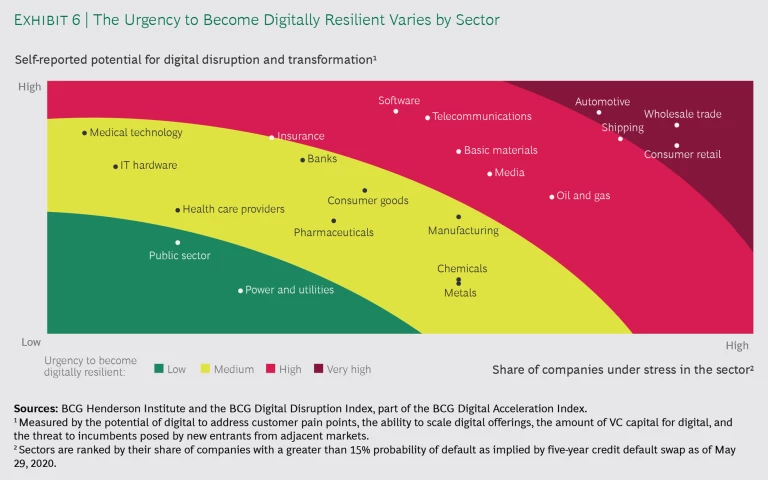
Two key factors will determine the urgency and need for resilience. (See Exhibit 6.) One is the expected financial impact of crises such as COVID-19 in a sector, indicated by the current level of financial distress. The other is the potential for digital disruption, which can be measured using
BCG’s Digital Acceleration Index (DAI)
.
In sectors where both the potential for digital disruption and the amount of financial distress are high, businesses should treat investing in digital resilience as a matter of urgency. For example, after COVID-19 hit a premium beauty products retailer in Europe hard, the company used advanced analytics to more accurately predict daily demand. This enabled the retailer to quickly reduce its order volumes by 30% even as it prevented stock-outs, thereby increasing its working capital. Buoyed by its success, the company is now using machine learning to develop state-of-the-art demand-management capabilities. Doing so will allow it to respond to future disruptions even more effectively.
Step 3: Build Sustainable Advantage
Finally, companies must invest in developing sustainable advantage by building long-term resilience. To do that, they need to identify the gaps between their ambitions and their current resilience maturity.
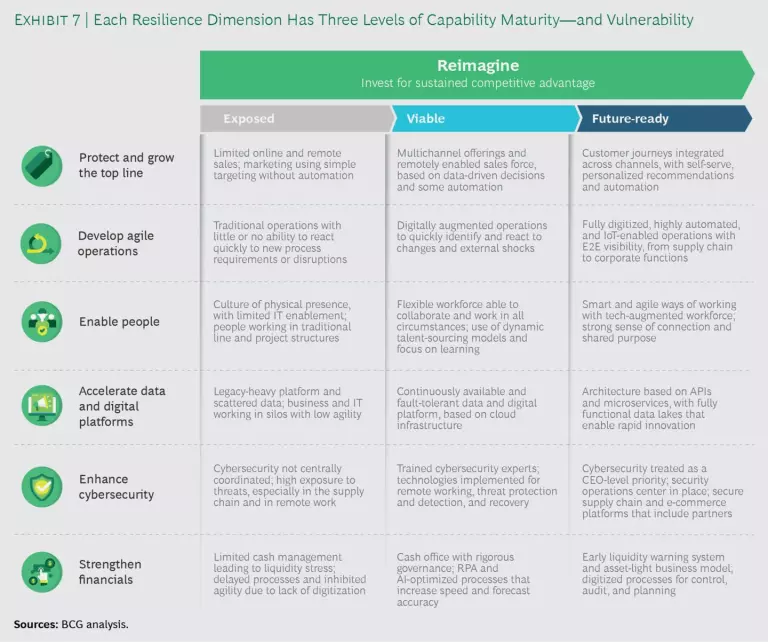
Each resilience dimension encompasses rising levels of capabilities at three distinct levels of maturity, which we label exposed, viable, and future-ready. (See Exhibit 7.) By referring to this exhibit, business leaders can quickly assess their company’s maturity on each dimension. They can also use detailed assessments, such as BCG’s DAI, to gain precise insights into where they stand and what actions they should take for maximum impact.
A company must immediately take steps to tackle the dimensions on which it is exposed. The minimum goal should be to ensure that the company is viable—if not future-ready—on all six dimensions. That’s particularly true in the areas of financial strength and cybersecurity, where vulnerability may spell disaster during the next crisis a company faces. Once a company is viable on every dimension, it can work to become future-ready on the dimensions that it believes are necessary to weather future crises and to differentiate itself in the marketplace.
After a company has determined its priorities, it must rethink its digital strategy and roadmap, and reset its investment portfolio accordingly. Projects that were top-of-mind six months ago may not be priorities anymore, and staying the course until the next planning cycle is likely to be a losing strategy.
The COVID-19 crisis has turned the spotlight on the urgent need for companies to become resilient, and the importance of digital technologies in making this transformation. As markets and economies are likely to continue to change rapidly, uncertainty will persist. Only a small group of resilient companies will be able to capitalize on the opportunity to grow stronger in the face of uncertainty. Investing in digital resilience will help companies both accelerate out of crises quickly and create sustainable competitive advantage in the new reality.











